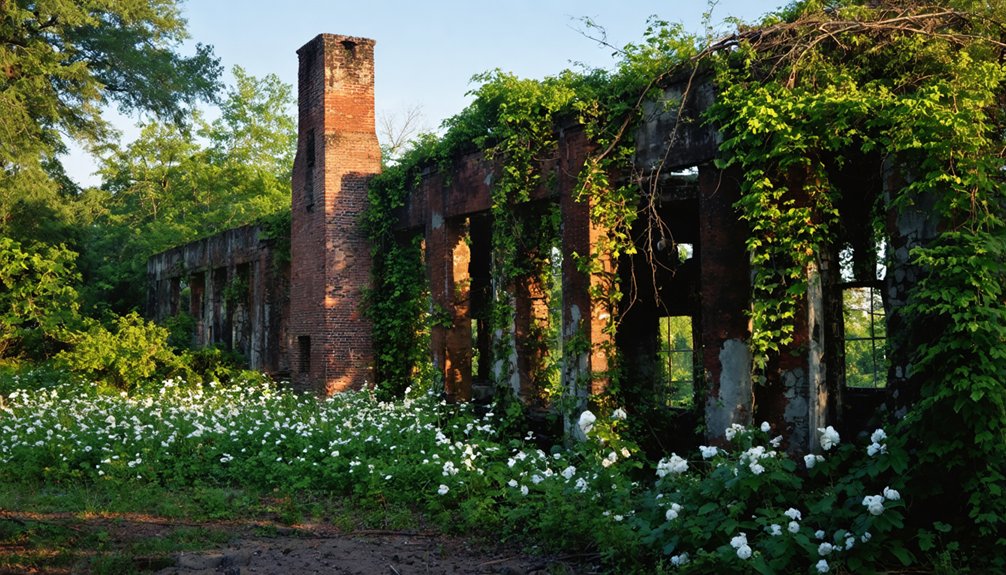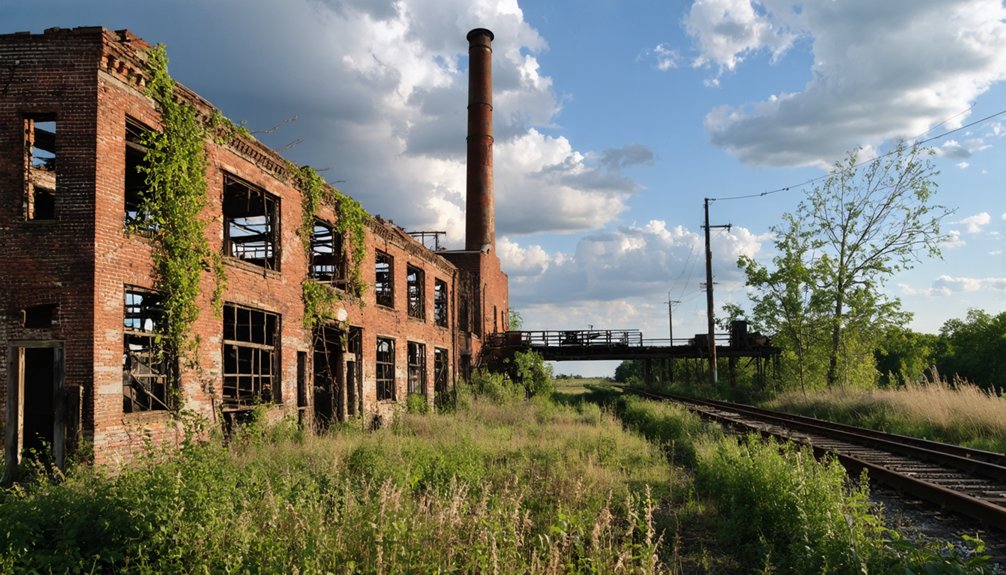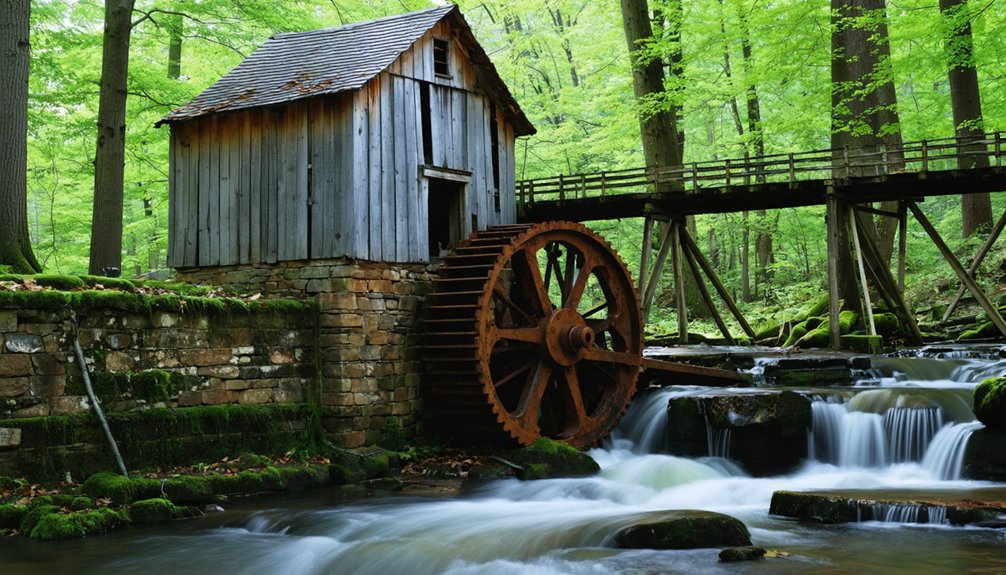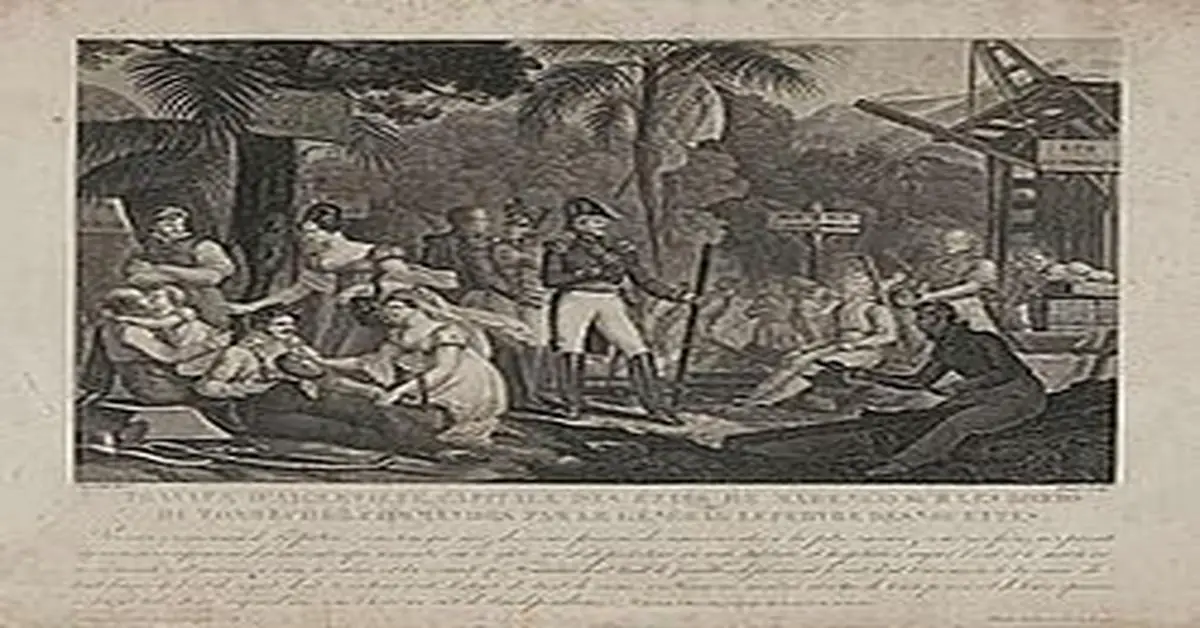You’ll find Mountain Mills in Colbert County, Alabama, where local investors founded a cotton mill town in 1872 with $75,000 in stock capital. The three-story brick factory, complete with a 100-foot smokestack, anchored a self-contained community featuring worker housing, a commissary, and schools. After thriving through the early 1900s, the mill’s closure during the 1930s economic downturn triggered a mass exodus, leaving behind crumbling structures that tell a compelling story of Southern industrial ambition.
Key Takeaways
- Mountain Mills was established in 1872 as a cotton mill town in Colbert County, Alabama, with a three-story brick factory.
- Workers endured harsh conditions, working 12-hour shifts for low wages while living in company housing with minimal amenities.
- The community thrived around three social hubs: church-schoolhouse, company store, and family gatherings before its decline.
- Economic downturn in the 1930s led to the mill’s closure, triggering mass employment migration and community destabilization.
- By the late 1960s, the last store closed, and the abandoned buildings deteriorated, leaving only foundations and scattered artifacts.
The Rise of a Cotton Mill Community
In 1872, a group of wealthy local investors established the Mountain Mill Company in rural Colbert County, Alabama, marking a significant shift toward Southern industrialization after the Civil War.
With $75,000 in stock capital, led by N. F. Cherry, they launched an ambitious venture into cotton production that would transform the local landscape.
You’ll find the heart of their industrial innovation in the massive three-story brick factory they built, spanning 100 by 200 feet, complete with a towering 100-foot smokestack.
They spared no expense, bringing in specialized machinery from New Jersey. Around this industrial core, they created a self-contained community with worker housing, a commissary, and a combination church-school building that still stands in the Barton area today. The community grew to include approximately 300 residents who worked and lived around the bustling mill complex.
Workers at the mill earned between fifteen to seventy-five cents per day for their labor in the textile operation.
Life in a Southern Industrial Town
You’d find Mountain Mills’ workers rising early each morning to begin their shifts at the three-story brick factory, where the sounds of imported New Jersey machinery filled the air.
Your daily routine would include long hours operating dangerous equipment alongside multiple generations of local families like the Blankenships and Burrows, with women and children making up a significant portion of the workforce. The mill, which began with a modest investment of $100,000, grew into a multimillion-dollar operation.
After work, you’d gather with fellow mill families at the company store run by Houston Ramsey or at the combination church-schoolhouse, where community life centered around religious services and social activities. Many workers accumulated debt to the company through purchases at these company-owned stores.
Mill Workers’ Daily Routine
Life as a mill worker in Mountain Mills meant enduring grueling 12-hour shifts that began at dawn and stretched into the evening, six days a week.
You’d spend your entire day surrounded by deafening machinery and choking dust, operating dangerous equipment with minimal safety protection. Workers had to develop ways to communicate despite the noise levels in mills. If you were a child, you’d dart between the machines as a doffer or sweeper, while adults managed multiple pieces of equipment simultaneously. Workers were required to conduct circuit checks at the start of every shift to ensure machinery was functioning properly.
Living in company housing near the mill, you’d wake before sunrise and walk to work.
The summer heat inside the mill would be unbearable, with poor ventilation making breathing difficult.
Your meager wages, sometimes as low as 10 cents per day, would be spent at the company store, where inflated prices kept you in constant debt to your employer.
Community Social Gatherings
While the mill dominated working hours at Mountain Mills, community life centered around three essential social hubs – the combination church-schoolhouse, the company store run by Mr. Houston Ramsey, and family gatherings that strengthened social resilience among workers.
You’d find community bonding opportunities through:
- Religious services led by preachers E.C. Fuqua and J.D. Tant, where families gathered for worship and fellowship
- School functions managed by Professor Blaylock and E.C. Hamilton, bringing together multiple generations
- Daily interactions at the company store, where families like the Blankenships, Burrows, and Keetons maintained social networks
- Church and school celebrations that united mill workers beyond their factory roles
These gatherings created a tight-knit community despite the industrial setting’s demands, weaving together work, faith, and family relationships. The community spirit echoed that of other mill towns like the Pell City Manufacturing Company, which built over one hundred houses and community facilities for their workers in 1902.
Economic Impact and Employment
Since the decline of its primary industries, Mountain Mills has experienced significant economic challenges typical of ghost towns. The closure of industrial workplaces triggered widespread employment migration, forcing residents to seek jobs elsewhere.
You’ll find that this exodus created a ripple effect, deterring new investments and further weakening the local economy. Similar to Easonville’s fate in the 1960s, many families were forced into unwanted relocation due to economic pressures.
Like many similar communities, Mountain Mills struggled to diversify its economy beyond its original industrial base. The town’s workforce faced difficulties adapting to new industries, particularly given the limited opportunities in rural Alabama.
While the region’s forestry industry continues to provide some economic stability in surrounding areas, Mountain Mills itself hasn’t benefited from these opportunities. The lack of sustainable employment options and decreased economic activity have made it challenging to maintain community liveliness. This stands in stark contrast to Alabama’s thriving forestry sector, which generates an impressive $36 billion in annual economic impact statewide.
Daily Operations at Mountain Mills
Operating from a massive three-story brick facility, Mountain Mills’ cotton production center buzzed with steam-powered machinery throughout its industrial years.
The daily operations revolved around transforming raw cotton into thread and cloth, with workers facing demanding schedules and strict rules that extended beyond working hours. In the 1860s, the facility operated at full capacity alongside other local cotton mills.
- You’d find women handling detailed, repetitive tasks requiring nimble fingers while men tackled the heavy labor and skilled positions.
- Houston Ramsey managed the company store, controlling workers’ access to essential goods.
- Steam-powered machinery, purchased from New Jersey, required constant monitoring and adjustments.
- Workers endured harsh conditions including cotton dust exposure and intense noise levels.
The workforce challenges included managing a labor force of men, women, and children while maintaining production efficiency through specialized task assignment and mechanized processes.
The Decline of the Cotton Industry

As economic pressures mounted in the early 20th century, Mountain Mills faced a series of devastating challenges that would eventually force its closure. The mill’s outdated machinery couldn’t compete with modernized facilities, while cotton market challenges intensified during the Great Depression.
You’d have found workers, mostly women and children, enduring harsh conditions for minimal wages – a clear example of labor exploitation that defined the era.
The mill’s attempt to adapt by relocating to Florence and becoming Cherry Cotton Mill proved futile. Despite diversifying into wool production and maintaining a controlled mill village system, the operation couldn’t survive the economic downturn of the 1930s.
The closure left hundreds of workers jobless, destroying the community’s economic foundation and forcing many families to migrate in search of new opportunities.
Abandonment and Ghost Town Status
As Mountain Mills’ cotton mill operations declined, you’ll find that the town’s population rapidly decreased throughout the mid-20th century, with most families relocating to find work in larger industrial centers.
The buildings and infrastructure you’d have seen during the town’s peak fell into severe disrepair, with the mill’s machinery being sold for scrap and houses abandoned as maintenance costs became prohibitive.
While small-scale retail businesses tried to persist into the early years of decline, the last operating store in Mountain Mills closed its doors by the late 1960s, marking the final shift to ghost town status.
Population Exodus Timeline
While the exact date of Mountain Mills’ abandonment remains unrecorded, the town’s shift to ghost town status likely occurred through a gradual exodus triggered by the mill’s closure.
The population trends and migration patterns followed a predictable sequence as the town’s economic foundation crumbled:
- Initial workforce departure, primarily consisting of women and children who made up the mill’s labor force
- Family exodus, including the Blankenships, Burrows, and Inmans, as employment opportunities vanished
- Community leaders’ departure, such as Professor Blaylock, E.C. Hamilton, and religious figures like E.C. Fuqua
- Final residents’ relocation as infrastructure maintenance ceased and basic services became unsustainable
Without the mill’s economic engine, you’d have witnessed the systematic unraveling of Mountain Mills’ social fabric as residents sought opportunities elsewhere.
Physical Deterioration Records
Since Mountain Mills fell into disuse, the physical deterioration of its structures has followed a predictable pattern of decay.
You’ll find deterioration effects most evident in the crumbling cotton mill buildings, where exposed frameworks and rotting wooden beams reveal decades of neglect. The preservation challenges are stark – foundations have weakened from constant water damage, while industrial machinery rusts in place among scattered debris.
Nature’s reclamation is unmistakable as you explore the site. Vines climb the deteriorating walls, trees push through abandoned floors, and wildlife has claimed the empty spaces.
You can trace the town’s original layout through remaining foundations, while artifacts like broken pottery and glass litter the ground, telling the story of Mountain Mills’ slow transformation into a true ghost town.
Last Active Industries
The relocation of Mountain Mills‘ industrial complex to Florence, Alabama in 1892 marked the final chapter of the town’s productive era.
Before this decisive move, you would’ve found a thriving multi-industry hub that showcased the ambition of Southern manufacturing independence.
The last active industries at Mountain Mills included:
- Cotton mill operations producing thread and cloth under Mountain Mill Company
- Steam-powered sawmill and grist mill sharing a single boiler
- Foundry and machine shop staffed by skilled imported labor
- Saturday community grain grinding services
The labor dynamics shifted dramatically when N.F. Cherry and other entrepreneurs chose to transfer their industrial investments to Florence.
This move effectively ended Mountain Mills’ role as a significant employer, leading to rapid depopulation and the town’s eventual ghost town status.
Historical Significance in Alabama
Located in Colbert County, Alabama, Mountain Mills emerged as a significant logging community during the late 19th century, contributing substantially to the state’s timber economy.
The town’s logging significance extended beyond mere resource extraction, shaping the region’s development and employment patterns. As you explore Alabama’s cultural heritage, you’ll find Mountain Mills represents an essential piece of the state’s rural history.
The community’s story mirrors broader patterns seen across Alabama, where resource-based economies flourished briefly before declining.
Today, Mountain Mills stands as a reflection of the state’s evolving economic landscape. While the bustling logging operations have long since ceased, the town’s historical importance lives on through preservation efforts and its role in helping scholars understand Alabama’s dynamic past.
What Remains Today

Modern-day visitors to Mountain Mills will find precious few remnants of its once-thriving logging community, as most physical structures have succumbed to flooding, decay, and hydroelectric development projects.
While the town’s original footprint lies largely underwater, you’ll discover historical remnants scattered throughout the surrounding area, preserved through community stories and local preservation efforts.
What you can still find today:
- Preserved gravesites that mark the town’s original location
- Relocated structures from Mountain Mills in nearby communities
- Artifacts from local industries, including tools and factory remnants
- Natural reclamation of the landscape, with vegetation covering former town areas
Local historical societies maintain maps and records for those seeking to explore the ghost town’s legacy, though access to the original site remains limited due to flooding and private property restrictions.
Frequently Asked Questions
Were There Any Notable Crimes or Murders in Mountain Mills?
You won’t find documented historical crimes or unsolved mysteries in the town’s records. While regional folklore mentions outlaws in nearby caves, no confirmed violent incidents occurred at this location.
Did Native American Tribes Live in the Area Before Mountain Mills?
You’d find the Chickasaw and Cherokee peoples living, hunting, and thriving here before Mountain Mills existed. They’d established strong communities until treaties and forced removal in the early 1800s changed everything.
What Natural Disasters Affected Mountain Mills During Its Operation?
You’ll find that while flood damage likely affected riverside operations regularly, and tornado destruction was possible in Alabama’s storm-prone region, no specific catastrophic natural disasters are documented during 1903-1925.
Are There Any Documented Paranormal Activities in Mountain Mills?
After searching through a million records, you won’t find any documented ghost sightings or haunted locations in this area. There’s no concrete evidence of paranormal activity despite its ghost town status.
Did Mountain Mills Have a Post Office During Its Active Years?
Yes, you’ll find that Mountain Mills had an operational post office from 1883 to 1893, providing essential community services until its closure coincided with the shutdown of local industrial operations.
References
- https://digitalalabama.com/alabama-ghost-towns/alabama-ghost-towns/9449
- https://deepsouthurbex.com/2020/01/02/6-south-alabama-ghost-towns/
- https://www.youtube.com/watch?v=Hcbb0-o2-f4
- https://digitalalabama.com/alabama-counties/colbert-county-alabama/colbert-county-alabama/1395
- https://freepages.history.rootsweb.com/~gtusa/usa/al.htm
- https://en.wikipedia.org/wiki/List_of_ghost_towns_in_Alabama
- https://www.algenweb.org/colbert/history-mtmills.htm
- https://louis.uah.edu/cgi/viewcontent.cgi?article=1575&context=huntsville-historical-review
- https://omeka.lib.auburn.edu/items/show/429
- http://florencehistory.org/mills-and-textiles-1850-to-1899/


